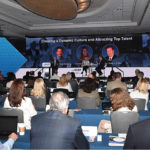 Dubai Museum |
The mid-afternoon sun bore down on us, but in March even the hottest time of day is cooled by a light breeze coming over the Dubai Creek, which divides Old and New Dubai. All along the creek you can see abras — wooden boats used as water taxis — taking visitors throughout the day to spice and textile marketplaces called souks.
Immersed as we were in traditional Emirati culture, it was barely evident that Dubai is developing at such a rapid pace. The world’s tallest building; the world’s tallest hotel; the first and only metro rail system in the Middle East — Dubai makes it a mission to break records, setting a new bar for the rest of the UAE. And with 72 percent of the world’s population within an eight-hour flight, events that come to Dubai often attract record-breaking attendance. The 2011 World Diabetes Congress welcomed more than 15,000 delegates, an all-time high for the conference.
“We’re thinking of things that no one else is,” said the Dubai Convention Bureau’s (DCB) Abdulrahim Baker, my guide during a week-long fam trip hosted by the DCB. He said this as we were eating lunch at Après, a Swedish-ski-lodge-inspired restaurant serving European cuisine that overlooks Ski Dubai — the first indoor ski resort in the Middle East. We looked on as skiers, snowboarders, and kids on sleds tore through the faux snow. Putting a mountain indoors is just one of the many ways that Dubai delivers the unexpected.
Despite the city’s fast growth over the last 20 years, traditional Emirati culture is everywhere in Dubai. On our second day, we toured Bastakiya, the oldest neighborhood in the city. The area is now utilized by nonprofit organizations and includes event space for up to 200 guests, several art galleries, a café, and a small guest house.
 Outdoor event space in Bastakiya Outdoor event space in Bastakiya |
One of many unique outdoor venues that Dubai offers, Bastakiya has a distinct design that keeps attendees cool with high wind towers and narrow pathways connecting the dusty tan buildings, providing shade from the desert sun — and a glimpse into early life in Dubai. In a courtyard nestled in the heart of Bastakiya, we sat in a circle barefoot, enjoying a full spread — cha-bab and khamir, the Emirati equivalent of pancakes and waffles; balaleet, an egg-and-noodle dish; and ligamats, the “doughnuts of the Gulf” — as our guide from the Sheikh Mohammed Center for Cultural Understanding explained Dubai’s unique history and customs, the diversity of its people (Dubai has a population that’s 85-percent expatriates, mostly from Asia, Europe, and the Persian Gulf countries), and the ins and outs of modern-day Islam in the UAE. The Sheikh Mohammed Center hosts walking tours and cultural breakfasts like these for groups twice a week.

My first few nights in the city were spent at the modern, five-star, 292-room Jumeirah Creekside Hotel, offering 25 state-of-the-art meeting rooms and approximately 2,000 square feet of conference space. On the second day of the trip, we traveled up to the 124th floor of the Burj Khalifa — the tallest building in the world, at more than 2,064 feet — and got a bird’s-eye view of Dubai. Afterwards, we ate local Emirati cuisine at Al Fanar, a new restaurant in Festival City, the lively 1,300-acre waterfront community in Dubai, offering a variety of shopping, dining, and entertainment options. Before each meal we’d have tea and dates, “to coat the stomach,” Baker explained. Dates, the fruit of the UAE, are used to cure everything from nausea to contusions to bland chabab.
For the remainder of my visit, I stayed in downtown Dubai, in the new, 804-room JW Marriot Marquis Dubai — the tallest hotel in the world, offering 55,488 square feet of meeting space and 27 meeting rooms. After the completion of its second tower next year, the hotel will offer 1,608 rooms.
During my free time, I attended Art Dubai, the leading international art fair in the Middle East, North Africa, and South Asia, drawing tens of thousands of attendees from around the globe annually. This year the festival – held March 20-23 at the Madinat Jumeirah hotel — showcased stunning contemporary pieces from the region, and included forums and educational workshops. “The way you define a place is always through people,” panelist and Palestinian artist Shuruq Harb said during the Global Arts Forum I attended. This proved to be true in Dubai, a vibrant city that is as diverse as its people.



